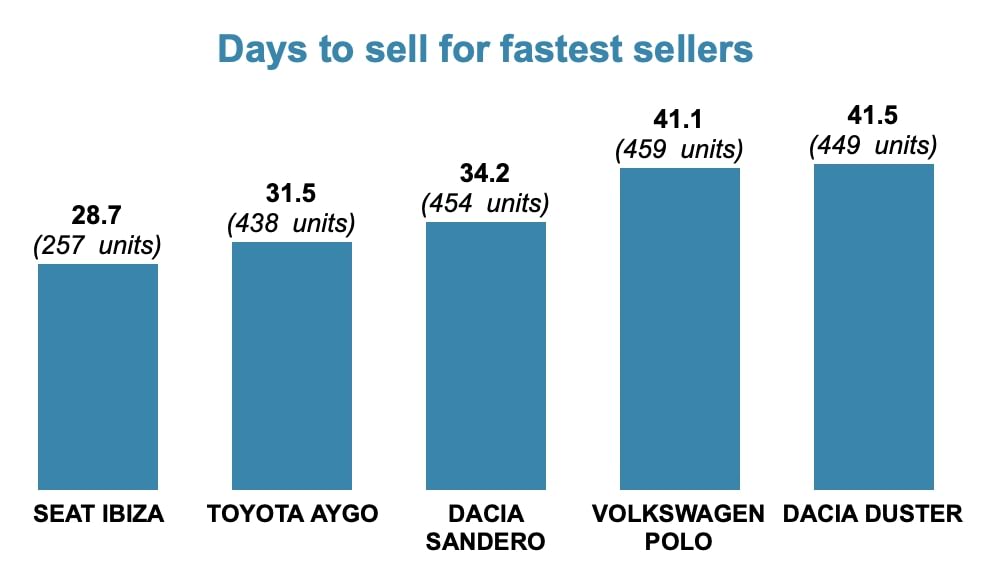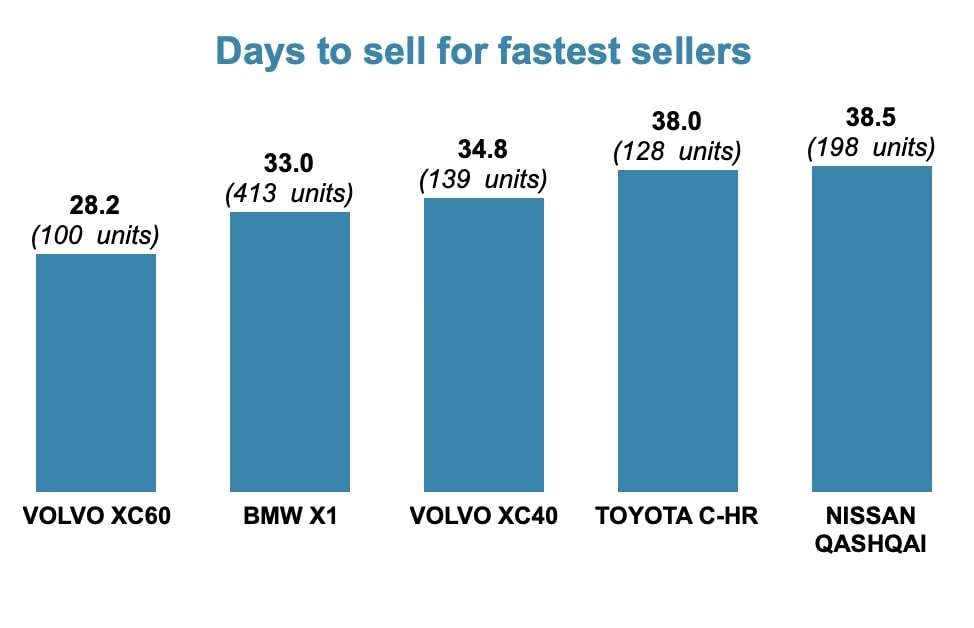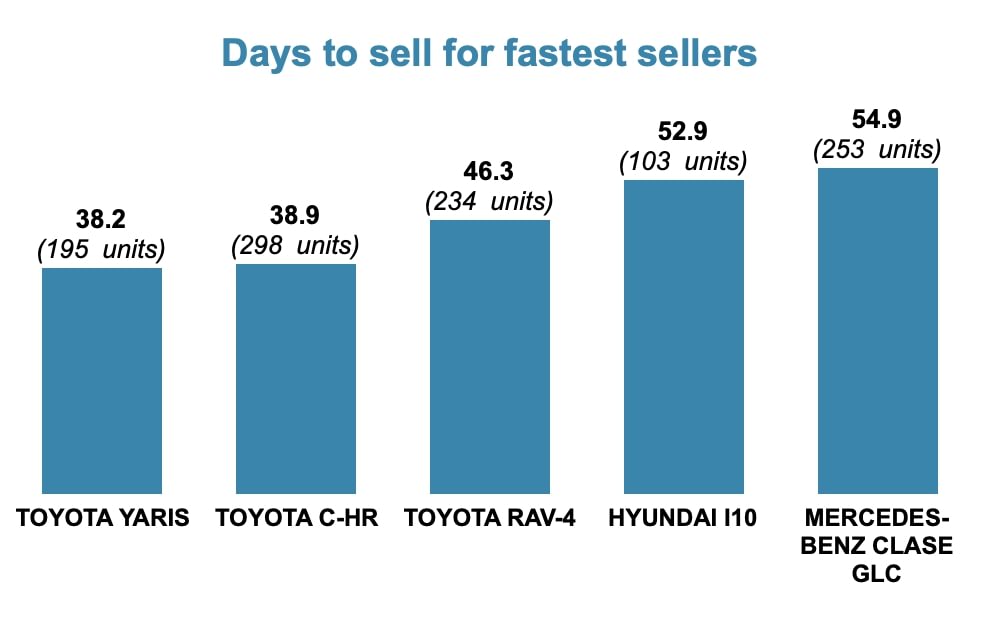- Blog
- Used Car Market in Europe: Q1 and Q2 2024 Trends and Analysis
Used Car Market in Europe: Q1 and Q2 2024 Trends and Analysis
Explore the latest trends in the European used car market for Q1 and Q2 2024, and discover key developments to help your dealership thrive in quarters to come.
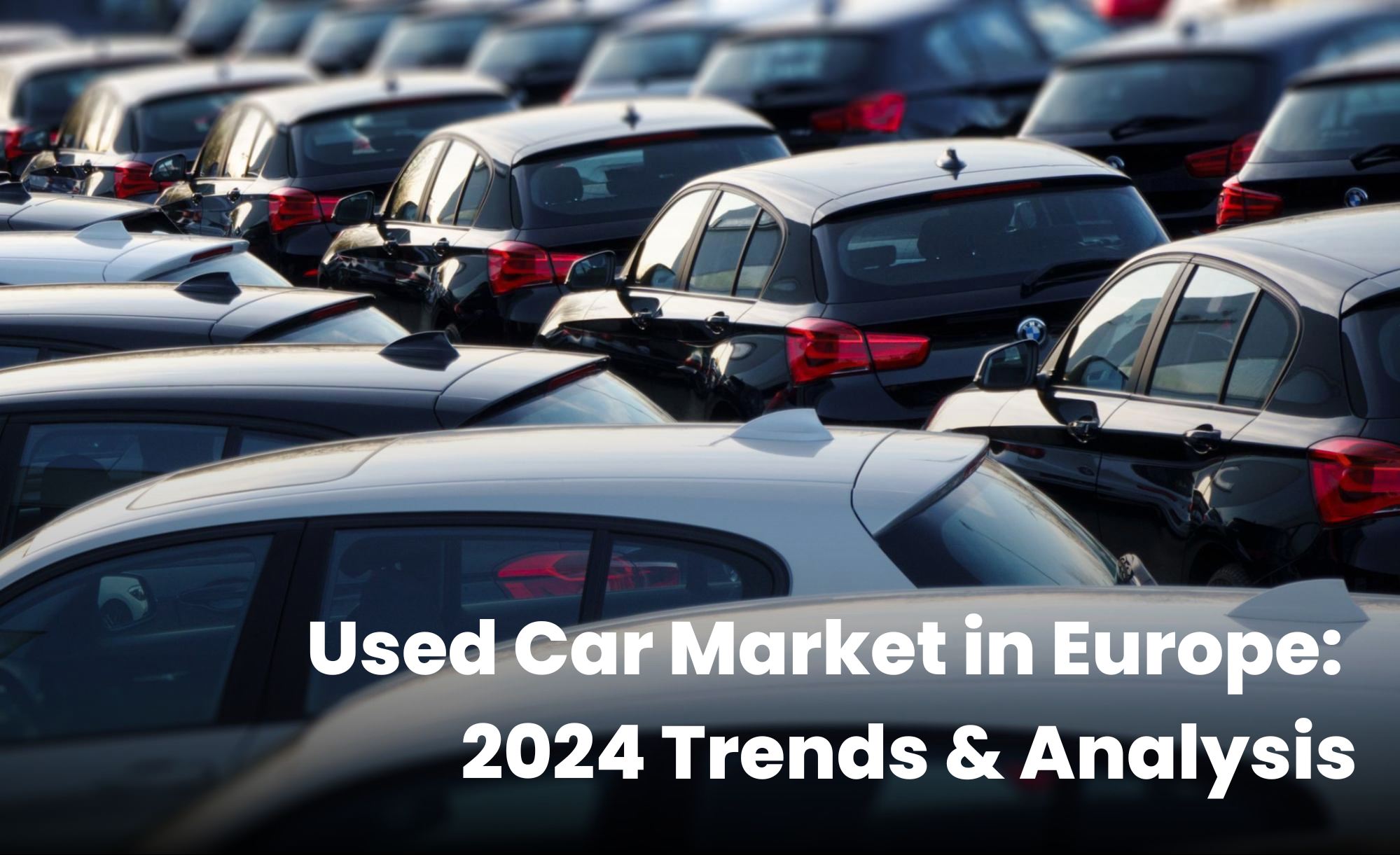
After the rollercoaster of 2023, marked by supply chain disruptions and inflation, 2024 has brought a refreshing change.
More precisely, the beginning of 2024 saw positive trends in used car transactions in France, Germany, Italy, and Spain. We’re talking about significant figures here—for instance, Italy has seen 8,5% more used car transactions than the year before.
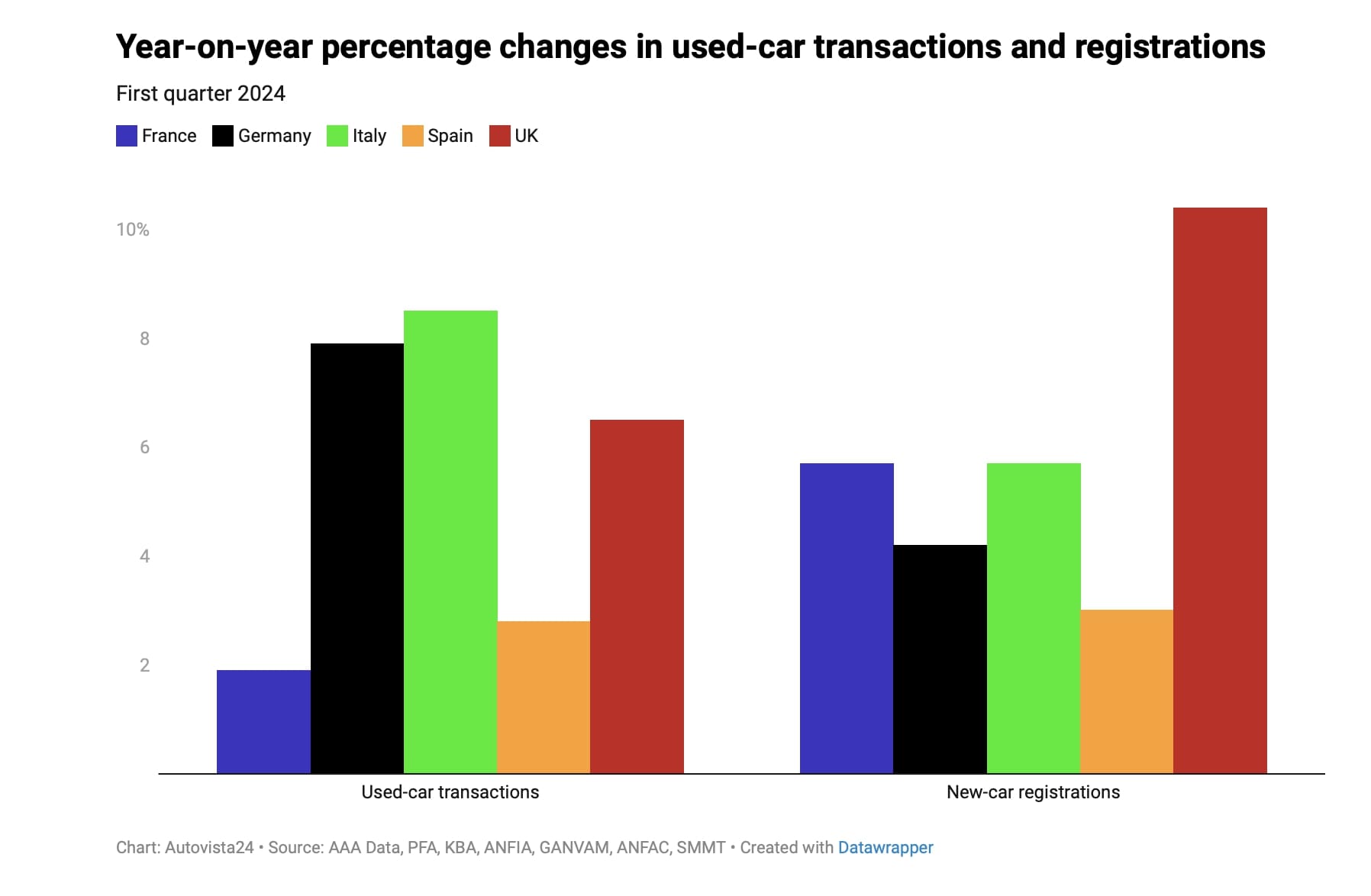 Source: Autovista24
Source: Autovista24
Still, there are two more quarters before the year is over, and many used car dealers are finding themselves navigating a market with fluctuating prices. That’s why we’ve prepared a breakdown of the key trends by country.
Let’s analyze Q1 and Q2 used car data to give you an understanding of market dynamics.
So, join us as we dive into the first two quarters of 2024, and you’ll be able to make informed decisions for the rest of the year.
Overview of the European used car market in Q1 and Q2 2024
EVs had a strong start at the beginning of this year. Autovista reports that it only took a used Volkswagen ID.3 an average of 42 days to sell in Germany.
February had a similar success, with used EVs, HEVs, petrol, and diesel vehicles selling at asking prices—not below them.
Still, there were fewer buyers for more expensive vehicles, so the dealers adjusted their strategies by not increasing their offer on those.
A relatively stable March allows us to fast-forward to April, when petrol and diesel vehicles sold faster than EVs in Europe.
May, however, saw a surge in hybrid vehicle sales again.
While general facts like these are helpful for determining what’s happening with the market on the whole, it’s better to include your specific location in the calculation, and that’s what we’ll help you do next.
Country-specific Q1 and Q2 used car market analysis
Each region has its own trends and challenges that are crucial for making informed decisions.
Examining the country-specific Q1 and Q2 used car market data will allow you to gain more precise insights relevant to your dealership’s needs. Let’s explore these detailed analyses so you can better navigate the market in your area.
Used car market in Germany
According to the most recent data from Autovista, market for used cars in Germany is showing signs of stability as of May 2024.
The average trade-in value of passenger cars saw a minor decrease of -0.2% compared to the previous month and a more substantial drop of -8.9% from a year ago.
In contrast, the average listed price increased slightly by 0.3% from the previous month and by 4.6% compared to the previous year.
When it comes to the number of cars sold, there was a significant increase of 16% compared to 2023.
Not all cars are sold at the same pace, of course. The VW ID.3 was the fastest seller, followed by Skoda KodiaQ, VW Passat, and the consistently popular Audi A3.
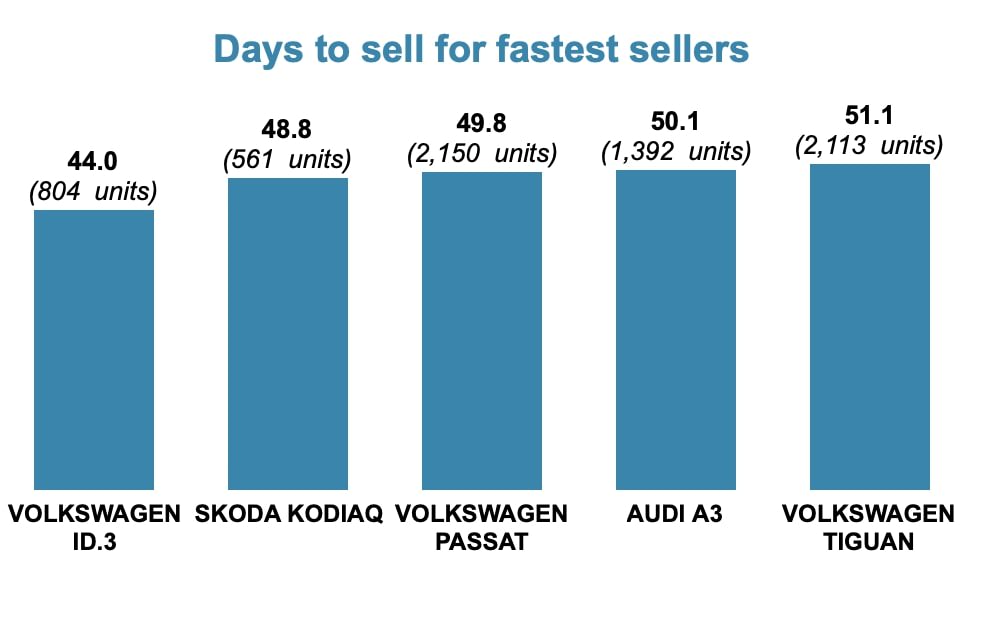
Fastest sellers in Germany in May 2024
There’s another fact to consider when sourcing cars for your dealership’s inventory in Germany.
Although direct purchase subsidies for EVs ended in 2024, there are still significant tax benefits for owning and using electric and hybrid vehicles. For instance, BEVs registered until 31 December 2025 enjoy a ten-year ownership tax exemption, extended until 31 December 2030.
So, there’s no need for car dealers to stop investing in hybrids and EVs.
But while electric and hybrid vehicles are increasingly popular, all fuel types can still be profitable. Just look at the list of fastest sellers!
Our extensive inventory includes various makes and models to suit all your needs, sourced directly from reputable European leasing companies, short-term rental companies and dealerships:
Used car market in France
A look at Autovista data for May 2024 reveals that although there aren’t drastic changes in car pricing, the market for used cars in France experienced slight dips in trade-in values (-0.2%).
Additionally, the number of cars sold has decreased by -4.4% compared to April 2024.
Despite these drops, there are two positive changes in the market.
The average time to sell a used car improved, decreasing by 2.2 days from the previous month, suggesting quicker sales.
Moreover, the active market volume index increased by 3.2%, which potentially indicates more buyer activity.
Customers seem to be particularly interested in small and economical cars, as the fastest sellers in France are Seat Ibiza, Toyota Aygo, and Dacia Sandero.
All things considered, Q1 and Q2 in France have shown some conflicting trends.
Conflicting figures suggest both a slowdown in sales volume and increased market activity. For car dealers, this means that while overall sales numbers have dropped, the cars that are on the market are selling faster.
These competitive market conditions make it crucial to stock the right inventory. Luckily, Autovista’s list of popular cars can help you see what kinds of passenger cars the customers are looking for.
If you’re specifically looking for top EVs in France as of May 2024, you can also check out this list created by the European Commission.
Used car market in Italy
Compared to other countries, the Italian used car market is experiencing a somewhat unique situation.
Namely, Autovista data suggests that there’s a drop in sales volume, while vehicles are sold at higher prices. Want to know more details?
The drop is quite significant, with the number of cars sold decreasing by -42.5% compared to the previous month and -38.4% from the previous year.
On the flip side, the cars that do get sold are fetching higher prices. The average listed price rose by 2.2% from the previous month and by an impressive 11.3% compared to the previous year.
These trends are also reflected in the list of fastest-selling cars in Italy. Take a look here:
At first, it seems that the market is doing fine, because the two fastest sellers (Volvo XC60 and BMW X1) are only averaging 28.2 and 33 days to sell—that’s similar to French trends.
However, if you look at the number of fastest sellers sold across Europe, you’ll notice that Italy has a significantly lower volume, indicating a slower overall market despite quick sales for specific models.
Essentially, having a wide selection of hit-and-miss models might not be the best strategy for dealers in Italy right now. It would instead be better to focus on high-demand vehicles so that dealers can compensate for the overall drop in sales volume with fewer but higher-priced sales.
Used car market in Spain
The first two quarters of 2024 were eventful in the Spanish used car market. Marked by a significant increase in sales volume, they show that there’s a demand for used vehicles despite longer average selling times.
In terms of total residual values, Q1 and Q2 of 2024 saw a slight decrease of -5.7% compared to 2023. Still, the comparison between April and May 2024 suggests that there are positive signs for the market, with the trade residual value rising by 0.5% between these two months.
Autovista data also reveals that the sales volume index for May 2024 increased significantly by 79.2% compared to the previous month and by 51.2% compared to the previous year. That’s a substantial rise!
Still, used cars aren’t quite flying off the lots.
Even the fastest-selling car, Toyota Yaris, takes 38 days to sell.
The model is followed by Toyota C-HR and Toyota RAV4, taking 38.9 and 46.3 days to sell, respectively.
Longer selling times are also in line with Spain having one of the oldest vehicle fleets in the EU, with an average age of 13.9 years.
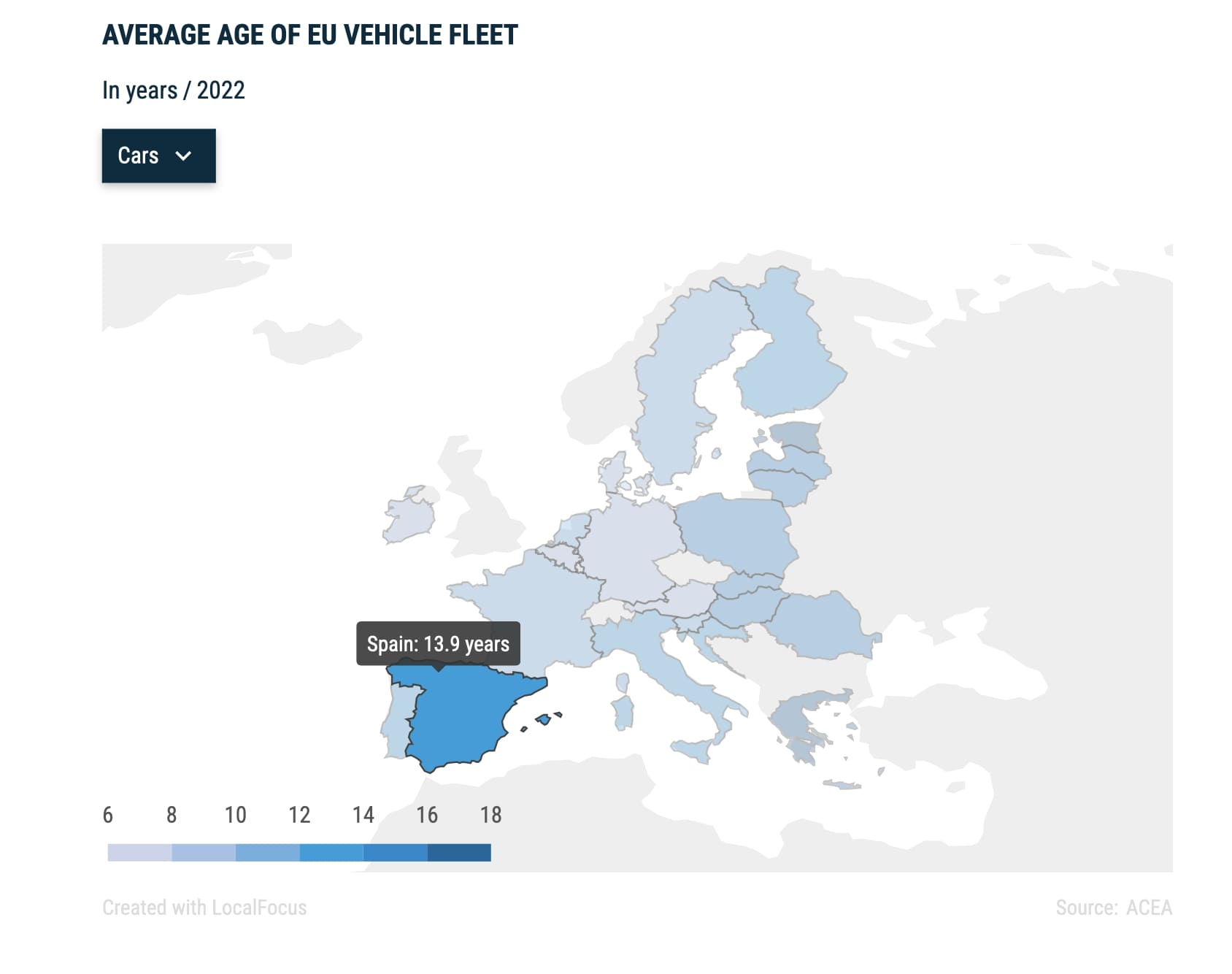 Source: ACEA
Source: ACEA
Older fleets could contribute to the slower turnover rates, as buyers may be more cautious and selective when purchasing used vehicles.
These trends reflect the complex dynamics of the Spanish used car market, where demand remains strong, but dealers may need to adapt to longer selling periods.
Electric and hybrid used car market in Europe
If you scan the top sellers across the major European regions we discussed above, you’ll see a fair share of EVs on the lists.
However, the EV boom seems to have quieted down compared to the previous years. The trend is also evident with new cars, with battery-electric vehicles making up 12.5% of the EU car market in May 2024, down from 13.8% a year ago.
A possible reason for the decreased enthusiasm could lie in several factors:
- High prices of new BEVs
- Lack of availability of private charging
- Too few public recharging points
This doesn’t mean that environmentally concerned buyers have lost interest in eco-friendly vehicles. Instead, they’re turning towards hybrids.
According to ACEA, despite the overall market decline, hybrid-electric was the only segment that has seen growth. This new car data translates to the used car market as well, where the increasing popularity of hybrid vehicles is reflected in higher demand and quicker sales.
With more hybrid models becoming available and entering the used car market, consumers looking for eco-friendly options are more likely to choose hybrids because they are practical and benefit from better infrastructure support compared to BEVs.
eCarsTrade as a way for dealerships to source European cars easily
After you’ve seen the overview of your region’s market, you may have gotten some great ideas on which cars to stock in your dealership.
We’re here to help you—our platform eCarsTrade makes buying these vehicles easier than ever.
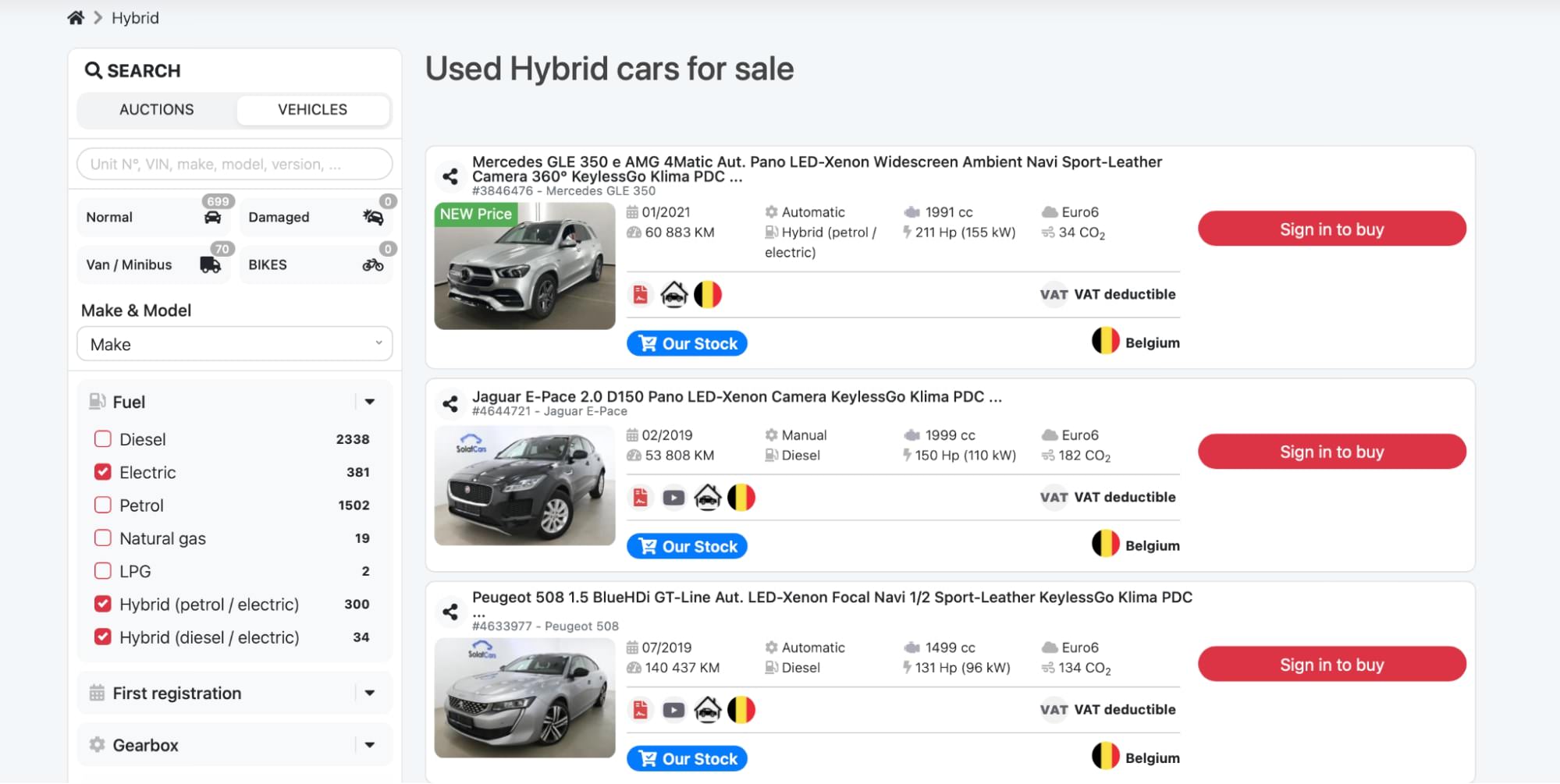 Constantly updated hybrid listings
Constantly updated hybrid listings
The platform lists hundreds of vehicles from various active EU auctions, meaning that used car dealers can access a wide range of ex-lease cars for sale all in one place.
We offer two types of auctions: blind and open. In blind auctions, you submit your bid without knowing others’ bids, while in open auctions, you can see and respond to competing bids in real-time.
Not interested in bidding? No problem! You can also find vehicles available at fixed prices, providing a straightforward purchase option.
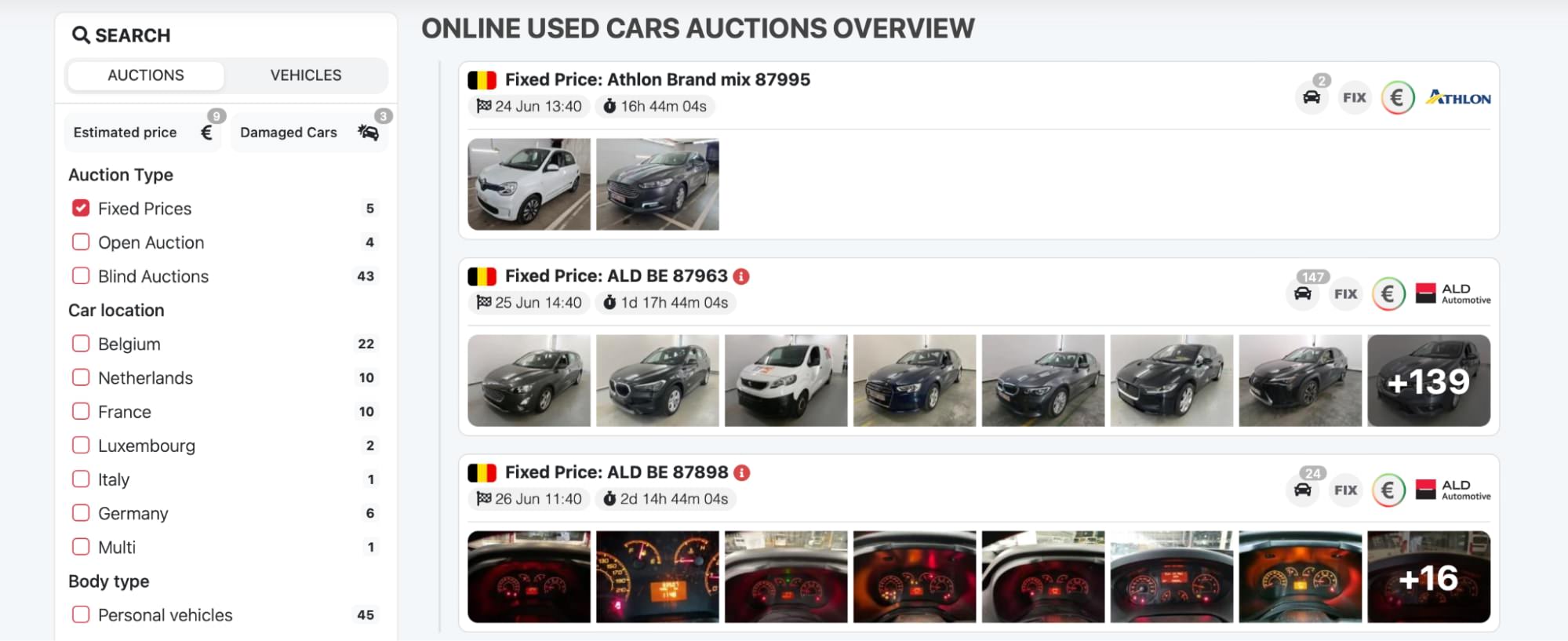
Whatever option you choose, our staff is here to assist in any way you need, be it arranging transit license plates, preparing customs declarations, or anything else you need to expand your inventory.
Stock up on time, and you’ll be ready for anything that Q3 and Q4 bring.
Factors driving used car market trends in Q1 and Q2 2024
Changes in the market rarely occur randomly; there are usually reasons behind customer behavior.
Learning about the factors that influence these trends can help you truly understand both the market dynamics and customer preferences.
So, here’s an overview of key factors that have shaped 2024 so far:
Government policies and incentives
Various European countries offer tax benefits, subsidies, and incentives for purchasing eco-friendly vehicles, boosting the demand for electric and hybrid cars in the used car market. For instance:
- Germany offers 10-year tax exemptions for BEVs and FCEVs registered until 31 December 2025. Although the exemption doesn’t apply to used cars, it boosts the used car market by increasing the supply of affordable EVs.
- France supports citizens with the ecological bonus, providing financial assistance for purchasing or leasing low-emission vehicles, used cars included.
- Italy offers different incentives to promote the purchase of low-emission vehicles, such as the National Purchase Subsidy for Private Individuals. Overall, Italy has allocated €250 million for BEVs for the years 2022, 2023, and 2024.
Incentives like these encourage the adoption of electric and hybrid vehicles, which also means they are available as used cars.
Economic conditions
The falling inflation, coupled with moderate economic growth, has supported steady demand for used cars.
A shift in consumer preferences
There has been a noticeable shift towards more fuel-efficient and environmentally friendly vehicles. Rising fuel prices, in addition to environmental awareness, have also driven more consumers to choose hybrids and EVs.
Bid on second-hand EVs from Europe!
Look at the cost of driving 100 km in Europe, and you’ll understand the appeal that customers see when choosing cars to buy.
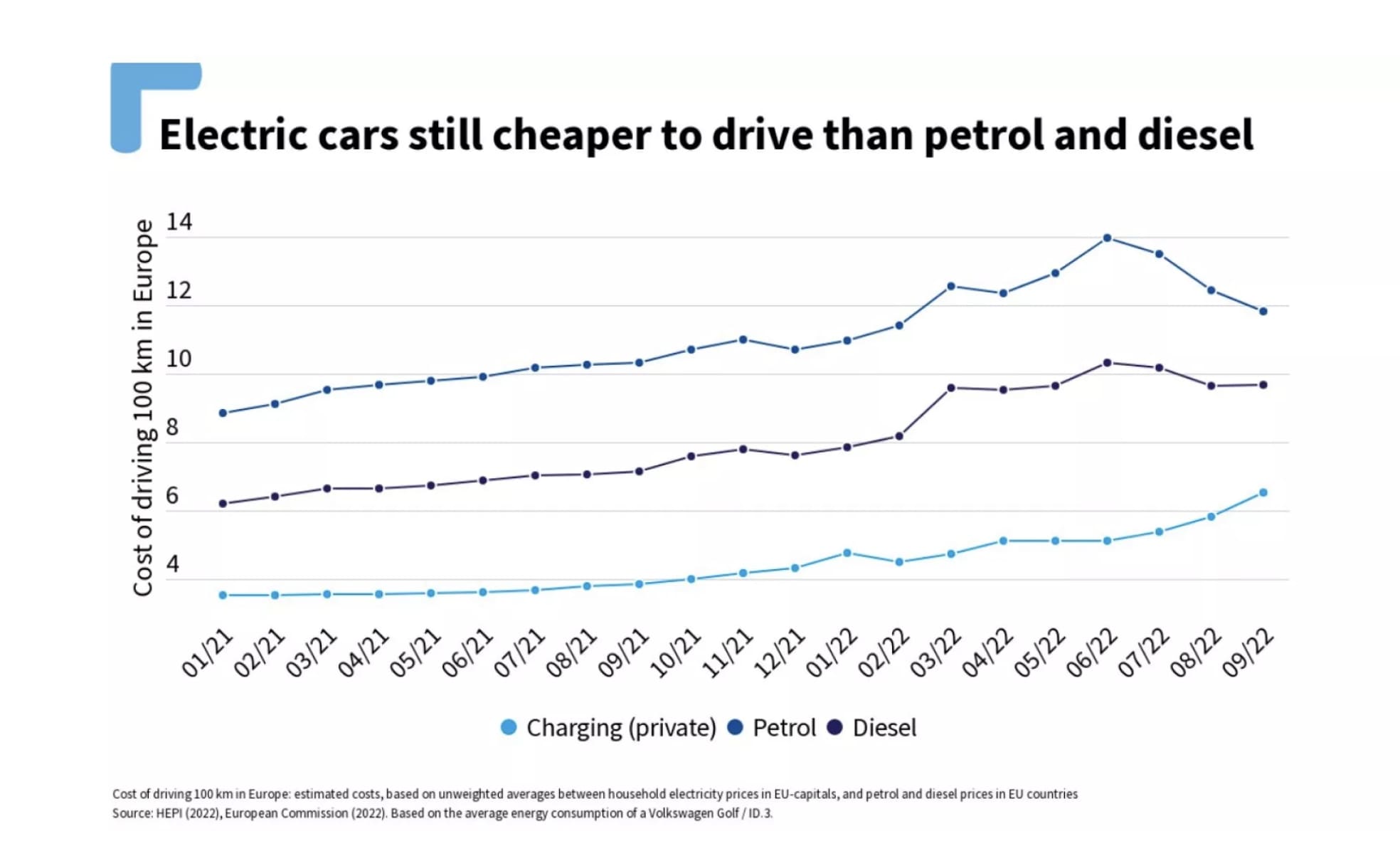 The cost of driving 100 km in Europe
The cost of driving 100 km in Europe
Essentially, whether customers are looking for planet-friendly vehicles or spending less money long-term, EVs and hybrids are attractive options.
Technological advancements
Innovations in vehicle technology, such as improved battery life for EVs and enhanced fuel efficiency for hybrids, have made these cars more attractive to consumers.
Don’t forget about the tech advancements in the market itself, such as online marketplaces. These have also shaped the way that customers purchase used cars.
Of course, you should also keep in mind that customers aren’t completely satisfied with the existing number of charging points across Europe, so we expect traditionally-powered cars to keep their presence on the market despite all the advancements.
Aging vehicle fleets
The average European age of light commercial vehicles is 12 years. As these vehicles age and become less reliable, private and business consumers are more likely to seek out newer models that offer better performance, safety, and fuel efficiency—even if they’re used.
So, it’s not just one factor; it’s the combination of economic, political, and technological key developments that’s shaping the used car market.
Did used car prices get lower in 2024?
If you’ve read our predictions about car prices in 2024, you may recall that we suggested three possible scenarios. One of these turned out to be accurate—and that was our baseline scenario.
Closely to what was anticipated, used car prices have indeed decreased slightly. This subtle decrease makes used cars more available to customers and provides opportunities for dealers to rotate their stock efficiently.
In other words, 2024 is a good year to be in the used car business, as both supply and demand are there.
Conclusion
If your business has survived the post-pandemic inflation, it can survive anything.
Luckily, there don’t seem to be any major calamities to worry about in the second half of 2024. The market has shown signs of stability and modest recovery.
Optimistic trends in the number of cars sold and slightly decreased used car prices suggest a resilient market. The economic conditions and shifting consumer preferences towards hybrids and EVs are all definitely contributing to a positive outlook.
So, embrace these changes, keep your eye on the best ex-lease vehicle opportunities, and your dealership will be able to thrive.
